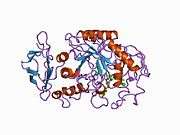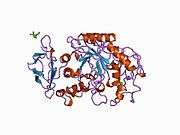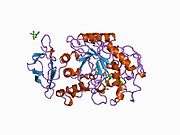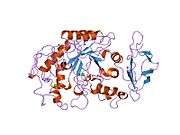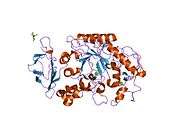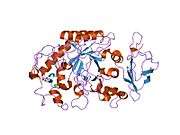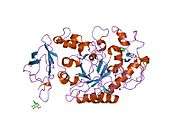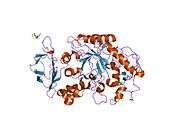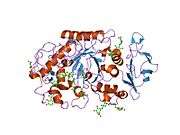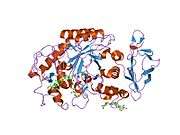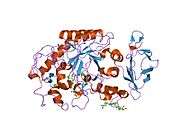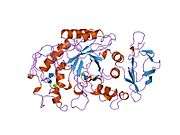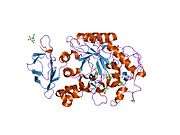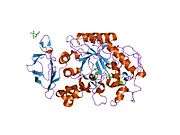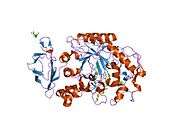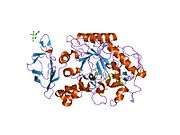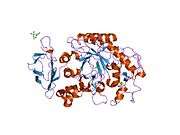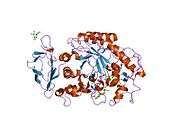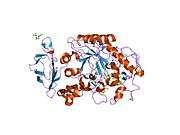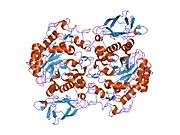AMY1A
| AMY1A
|
|---|
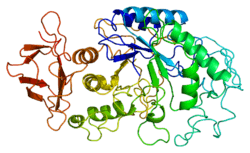 |
| Available structures |
|---|
| PDB | Human UniProt search: PDBe RCSB |
|---|
| List of PDB id codes |
|
1C8Q, 1JXJ, 1JXK, 1MFU, 1MFV, 1NM9, 1Q4N, 1SMD, 1XV8, 1Z32, 3BLK, 3BLP, 3DHP
| | |
| Identifiers |
|---|
| Aliases |
AMY1A, AMY1, amylase, alpha 1A (salivary) |
|---|
| External IDs |
HomoloGene: 133998 GeneCards: AMY1A
|
|---|
|
|
| Orthologs |
|---|
| Species |
Human |
Mouse |
|---|
| Entrez |
|
|
|---|
| Ensembl |
|
|
|---|
| UniProt |
|
|
|---|
| RefSeq (mRNA) |
| |
|---|
| RefSeq (protein) |
| |
|---|
| Location (UCSC) |
Chr 1: 103.66 – 103.66 Mb |
n/a |
|---|
| PubMed search |
[1] |
n/a
|
|---|
| Wikidata |
Alpha-amylase 1 is an enzyme that in humans is encoded by the AMY1A gene.[2] This gene is found in many organisms, see Alpha-Amylase.
Amylases are secreted proteins that hydrolyze 1,4-alpha-glucoside bonds in oligosaccharides and polysaccharides, and thus catalyze the first step in digestion of dietary starch and glycogen. The human genome has a cluster of several amylase genes that are expressed at high levels in either salivary gland or pancreas. This gene encodes an amylase isoenzyme produced by the salivary gland. Alternative splicing results in multiple transcript variants encoding the same protein.[2]
References
Further reading
- Bank RA, Hettema EH, Arwert F, et al. (1991). "Electrophoretic characterization of posttranslational modifications of human parotid salivary alpha-amylase.". Electrophoresis. 12 (1): 74–9. doi:10.1002/elps.1150120114. PMID 1710976.
- Groot PC, Mager WH, Henriquez NV, et al. (1991). "Evolution of the human alpha-amylase multigene family through unequal, homologous, and inter- and intrachromosomal crossovers.". Genomics. 8 (1): 97–105. doi:10.1016/0888-7543(90)90230-R. PMID 2081604.
- Nishide T, Nakamura Y, Emi M, et al. (1986). "Primary structure of human salivary alpha-amylase gene.". Gene. 41 (2–3): 299–304. doi:10.1016/0378-1119(86)90110-1. PMID 2423416.
- Davis MM, Hodes ME, Munsick RA, et al. (1986). "Pancreatic amylase expression in human pancreatic development". Hybridoma. 5 (2): 137–45. doi:10.1089/hyb.1986.5.137. PMID 2424823.
- Handy DE, Larsen SH, Karn RC, Hodes ME (1987). "Identification of a human salivary amylase gene. Partial sequence of genomic DNA suggests a mode of regulation different from that of mouse, Amy1". Mol. Biol. Med. 4 (3): 145–55. PMID 2442579.
- Horii A, Emi M, Tomita N, et al. (1988). "Primary structure of human pancreatic alpha-amylase gene: its comparison with human salivary alpha-amylase gene". Gene. 60 (1): 57–64. doi:10.1016/0378-1119(87)90213-7. PMID 2450054.
- Gumucio DL, Wiebauer K, Caldwell RM, et al. (1988). "Concerted evolution of human amylase genes". Mol. Cell. Biol. 8 (3): 1197–205. PMC 363264
 . PMID 2452973.
. PMID 2452973.
- Samuelson LC, Wiebauer K, Gumucio DL, Meisler MH (1988). "Expression of the human amylase genes: recent origin of a salivary amylase promoter from an actin pseudogene". Nucleic Acids Res. 16 (17): 8261–76. doi:10.1093/nar/16.17.8261. PMC 338557
 . PMID 2458567.
. PMID 2458567.
- Groot PC, Bleeker MJ, Pronk JC, et al. (1989). "The human alpha-amylase multigene family consists of haplotypes with variable numbers of genes". Genomics. 5 (1): 29–42. doi:10.1016/0888-7543(89)90083-9. PMID 2788608.
- Pronk JC, Frants RR, Jansen W, et al. (1982). "Evidence of duplication of the human salivary amylase gene". Hum. Genet. 60 (1): 32–5. doi:10.1007/BF00281260. PMID 6176528.
- Zabel BU, Naylor SL, Sakaguchi AY, et al. (1984). "High-resolution chromosomal localization of human genes for amylase, proopiomelanocortin, somatostatin, and a DNA fragment (D3S1) by in situ hybridization". Proc. Natl. Acad. Sci. U.S.A. 80 (22): 6932–6. doi:10.1073/pnas.80.22.6932. PMC 390100
 . PMID 6196780.
. PMID 6196780.
- Tricoli JV, Shows TB (1984). "Regional assignment of human amylase (AMY) to p22----p21 of chromosome 1". Somat. Cell Mol. Genet. 10 (2): 205–10. doi:10.1007/BF01534909. PMID 6608795.
- Nishide T, Emi M, Nakamura Y, Matsubara K (1984). "Corrected sequences of cDNAs for human salivary and pancreatic alpha-amylases [corrected]". Gene. 28 (2): 263–70. doi:10.1016/0378-1119(84)90265-8. PMID 6610603.
- Seyama K, Nukiwa T, Takahashi K, et al. (1994). "Amylase mRNA transcripts in normal tissues and neoplasms: the implication of different expressions of amylase isogenes". J. Cancer Res. Clin. Oncol. 120 (4): 213–20. doi:10.1007/BF01372559. PMID 7507116.
- Ragunath C, Sundar K, Ramasubbu N (2002). "Expression, characterization, and biochemical properties of recombinant human salivary amylase". Protein Expr. Purif. 24 (2): 202–11. doi:10.1006/prep.2001.1559. PMID 11858714.
- Hokari S, Miura K, Koyama I, et al. (2002). "A restriction endonuclease assay for expression of human alpha-amylase isozymes". Clin. Chim. Acta. 322 (1–2): 113–6. doi:10.1016/S0009-8981(02)00161-4. PMID 12104089.
- Furusawa M, Taira T, Iguchi-Ariga SM, Ariga H (2003). "AMY-1 interacts with S-AKAP84 and AKAP95 in the cytoplasm and the nucleus, respectively, and inhibits cAMP-dependent protein kinase activity by preventing binding of its catalytic subunit to A-kinase-anchoring protein (AKAP) complex". J. Biol. Chem. 277 (52): 50885–92. doi:10.1074/jbc.M206387200. PMID 12414807.
- Strausberg RL, Feingold EA, Grouse LH, et al. (2003). "Generation and initial analysis of more than 15,000 full-length human and mouse cDNA sequences". Proc. Natl. Acad. Sci. U.S.A. 99 (26): 16899–903. doi:10.1073/pnas.242603899. PMC 139241
 . PMID 12477932.
. PMID 12477932.
- Ramasubbu N, Ragunath C, Mishra PJ (2003). "Probing the role of a mobile loop in substrate binding and enzyme activity of human salivary amylase". J. Mol. Biol. 325 (5): 1061–76. doi:10.1016/S0022-2836(02)01326-8. PMID 12527308.
- Kandra L, Gyémánt G, Remenyik J, et al. (2003). "Subsite mapping of human salivary alpha-amylase and the mutant Y151M". FEBS Lett. 544 (1–3): 194–8. doi:10.1016/S0014-5793(03)00495-2. PMID 12782315.
PDB gallery |
|---|
|
| 1b2y: STRUCTURE OF HUMAN PANCREATIC ALPHA-AMYLASE IN COMPLEX WITH THE CARBOHYDRATE INHIBITOR ACARBOSE |
| 1bsi: HUMAN PANCREATIC ALPHA-AMYLASE FROM PICHIA PASTORIS, GLYCOSYLATED PROTEIN |
| 1c8q: STRUCTURE SOLUTION AND REFINEMENT OF THE RECOMBINANT HUMAN SALIVARY AMYLASE |
| 1cpu: SUBSITE MAPPING OF THE ACTIVE SITE OF HUMAN PANCREATIC ALPHA-AMYLASE USING SUBSTRATES, THE PHARMACOLOGICAL INHIBITOR ACARBOSE, AND AN ACTIVE SITE VARIANT |
| 1hny: The structure of human pancreatic alpha-amylase at 1.8 angstroms resolution and comparisons with related enzymes |
| 1jxj: Role of mobile loop in the mechanism of human salivary amylase |
| 1jxk: Role of the mobile loop in the mechanism of human salivary amylase |
| 1kb3: Three Dimensional Structure Analysis of the R195A Variant of Human Pancreatic Alpha Amylase |
| 1kbb: Mechanistic Analyses of Catalysis in Human Pancreatic alpha-Amylase: Detailed Kinetic and Structural Studies of Mutants of Three Conserved Carboxylic Acids |
| 1kbk: Mechanistic Analyses of Catalysis in Human Pancreatic Alpha-Amylase: Detailed Kinetic and Structural Studies of Mutants of Three Conserved Carboxylic Acids |
| 1kgu: THREE DIMENSIONAL STRUCTURE ANALYSIS OF THE R337A VARIANT OF HUMAN PANCREATIC ALPHA-AMYLASE |
| 1kgw: THREE DIMENSIONAL STRUCTURE ANALYSIS OF THE R337Q VARIANT OF HUMAN PANCREATIC ALPHA-MYLASE |
| 1kgx: Three Dimensional Structure Analysis of the R195Q Variant of Human Pancreatic Alpha Amylase |
| 1mfu: Probing the role of a mobile loop in human salivary amylase: Structural studies on the loop-deleted mutant |
| 1mfv: Probing the role of a mobile loop in human slaivary amylase: Structural studies on the loop-deleted enzyme |
| 1nm9: Crystal structure of recombinant human salivary amylase mutant W58A |
| 1q4n: Structural studies of Phe256Trp of human salivary alpha-amylase: implications for the role of a conserved water molecule and its associated chain in enzyme activity |
| 1smd: HUMAN SALIVARY AMYLASE |
| 1u2y: In situ extension as an approach for identifying novel alpha-amylase inhibitors, structure containing D-gluconhydroximo-1,5-lactam |
| 1u30: In situ extension as an approach for identifying novel alpha-amylase inhibitors, structure containing maltosyl-alpha (1,4)-D-gluconhydroximo-1,5-lactam |
| 1u33: In situ extension as an approach for identifying novel alpha-amylase inhibitors |
| 1xcw: Acarbose Rearrangement Mechanism Implied by the Kinetic and Structural Analysis of Human Pancreatic alpha-Amylase in Complex with Analogues and Their Elongated Counterparts |
| 1xcx: Acarbose Rearrangement Mechanism Implied by the Kinetic and Structural Analysis of Human Pancreatic alpha-Amylase in Complex with Analogues and Their Elongated Counterparts |
| 1xd0: Acarbose Rearrangement Mechanism Implied by the Kinetic and Structural Analysis of Human Pancreatic alpha-Amylase in Complex with Analogues and Their Elongated Counterparts |
| 1xd1: Acarbose Rearrangement Mechanism Implied by the Kinetic and Structural Analysis of Human Pancreatic alpha-Amylase in Complex with Analogues and Their Elongated Counterparts |
| 1xgz: Structure of the N298S variant of human pancreatic alpha-amylase |
| 1xh0: Structure of the N298S variant of human pancreatic alpha-amylase complexed with acarbose |
| 1xh1: Structure of the N298S variant of human pancreatic alpha-amylase complexed with chloride |
| 1xh2: Structure of the N298S variant of human pancreatic alpha-amylase complexed with chloride and acarbose |
| 1xv8: Crystal Structure of Human Salivary Alpha-Amylase Dimer |
| 1z32: Structure-function relationships in human salivary alpha-amylase: Role of aromatic residues |
| 2cpu: SUBSITE MAPPING OF THE ACTIVE SITE OF HUMAN PANCREATIC ALPHA-AMYLASE USING SUBSTRATES, THE PHARMACOLOGICAL INHIBITOR ACARBOSE, AND AN ACTIVE SITE VARIANT |
| 3cpu: SUBSITE MAPPING OF THE ACTIVE SITE OF HUMAN PANCREATIC ALPHA-AMYLASE USING SUBSTRATES, THE PHARMACOLOGICAL INHIBITOR ACARBOSE, AND AN ACTIVE SITE VARIANT |
|
|

 . PMID 2452973.
. PMID 2452973. . PMID 2458567.
. PMID 2458567. . PMID 6196780.
. PMID 6196780. . PMID 12477932.
. PMID 12477932.